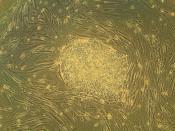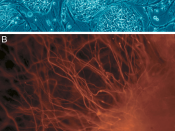Since the death of former President Ronald Regan, federal funding of embryonic stem cell research is a topic which continues to be present in our headlines. Some people feel that embryonic stem cells could produce a cure for the devastating disease of Alzheimer's. Nancy Reagan is now trying to influence President Bush to lift restrictions on federal funding for research using stem cells. Technical and medical advances are developing at an astronomical rate and the law needs to follow and help to shape these advances. Fetal tissues have been used for medical research for years so this is not a new idea in the medical community. Most all nations have been forced to re-examine their laws on genetic testing since the advances in embryonic stem cells, human genome mapping and human cloning.
Researchers were able to first isolate human embryonic stem (ES) cells in 1998. This discovery was made at the University of Wisconsin by biologist Dr.
James Thomson. But very little research was done on these cells due to the restrictions that were put in place by the by-laws of funding for the National Institutes of Health by the Congressional Appropriations committee. An appropriations bill that was passed on October 20, 1999 stated, " U.S. funds may not be used for the 'the creation of a human embryo ' for research purposes, or for 'research in which a human embryo or embryos are destroyed, discarded, or knowingly subjected to risk of injury or death'. The embryo is defined as any organism not protected as a human subject under laws (such as those applying to fetal tissue) 'That is derived by fertilization, parthenogenesis, cloning, or any other means from one or more human gametes or diploid cells." (Marshall, 1999) The isolation and culture of these cells caused much excitement...


